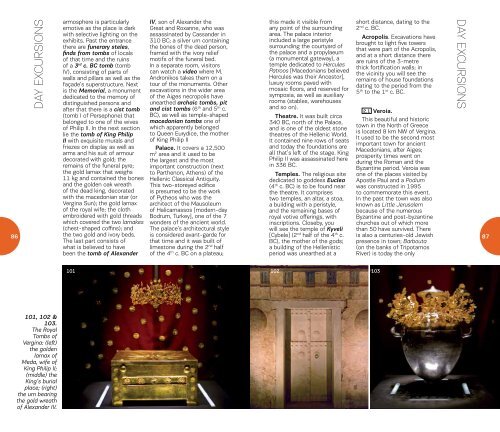Thessaloniki_EN
Create successful ePaper yourself
Turn your PDF publications into a flip-book with our unique Google optimized e-Paper software.
86<br />
DAY EXCURSIONS<br />
armosphere is particularly<br />
emotive as the place is dark<br />
with selective lighting on the<br />
exhibits. Past the entrance<br />
there are funerary steles,<br />
finds from tombs of locals<br />
of that time and the ruins<br />
of a 3 rd c. BC tomb (tomb<br />
IV), consisting of parts of<br />
walls and pillars as well as the<br />
façade’s superstructure. Next<br />
is the Memorial, a monument<br />
dedicated to the memory of<br />
distinguished persons and<br />
after that there is a cist tomb<br />
(tomb I of Persephone) that<br />
belonged to one of the wives<br />
of Philip II. In the next section<br />
lie the tomb of King Philip<br />
II with exquisite murals and<br />
friezes on display as well as<br />
arms and his suit of armour<br />
decorated with gold; the<br />
remains of the funeral pyre;<br />
the gold larnax that weighs<br />
11 kg and contained the bones<br />
and the golden oak wreath<br />
of the dead king, decorated<br />
with the macedonian star (or<br />
Vergina Sun); the gold larnax<br />
of the royal wife; the cloth<br />
embroidered with gold threads<br />
which covered the two larnakes<br />
(chest-shaped coffins); and<br />
the two gold and ivory beds.<br />
The last part consists of<br />
what is believed to have<br />
been the tomb of Alexander<br />
IV, son of Alexander the<br />
Great and Roxanne, who was<br />
assassinated by Cassander in<br />
310 BC; a silver urn containing<br />
the bones of the dead person,<br />
framed with the ivory relief<br />
motifs of the funeral bed.<br />
In a separate room, visitors<br />
can watch a video where M.<br />
Andronikos takes them on a<br />
tour of the monuments. Other<br />
excavations in the wider area<br />
of the Aiges necropolis have<br />
unearthed archaic tombs, pit<br />
and cist tombs (6 th and 5 th c.<br />
BC), as well as temple-shaped<br />
macedonian tombs one of<br />
which apparently belonged<br />
to Queen Eurydice, the mother<br />
of King Philip II<br />
Palace. It covers a 12,500<br />
m 2 area and it used to be<br />
the largest and the most<br />
important construction (next<br />
to Parthenon, Athens) of the<br />
Hellenic Classical Antiquity.<br />
This two-storeyed edifice<br />
is presumed to be the work<br />
of Pytheos who was the<br />
architect of the Mausoleum<br />
of Halicarnassos [modern-day<br />
Bodrum, Turkey], one of the 7<br />
wonders of the ancient world.<br />
The palace’s architectural style<br />
is considered avant-garde for<br />
that time and it was built of<br />
limestone during the 2 nd half<br />
of the 4 th c. BC on a plateau;<br />
this made it visible from<br />
any point of the surrounding<br />
area. The palace interior<br />
included a large peristyle<br />
surrounding the courtyard of<br />
the palace and a propylaeum<br />
(a monumental gateway), a<br />
temple dedicated to Hercules<br />
Patroos [Macedonians believed<br />
Hercules was their Ancestor],<br />
luxury rooms paved with<br />
mosaic floors, and reserved for<br />
symposia, as well as auxiliary<br />
rooms (stables, warehouses<br />
and so on).<br />
Theatre. It was built circa<br />
340 BC, north of the Palace,<br />
and is one of the oldest stone<br />
theatres of the Hellenic World.<br />
It contained nine rows of seats<br />
and today the foundations are<br />
all that’s left of the stage. King<br />
Philip II was assassinated here<br />
in 336 BC.<br />
Temples. The religious site<br />
dedicated to goddess Euclea<br />
(4 th c. BC) is to be found near<br />
the theatre. It comprises<br />
two temples, an altar, a stoa,<br />
a building with a peristyle,<br />
and the remaining bases of<br />
royal votive offerings, with<br />
inscriptions. Closeby, you<br />
will see the temple of Kyveli<br />
[Cybele] (2 nd half of the 4 th c.<br />
BC), the mother of the gods;<br />
a building of the Hellenistic<br />
period was unearthed at a<br />
short distance, dating to the<br />
2 nd c. BC.<br />
Acropolis. Excavations have<br />
brought to light five towers<br />
that were part of the Acropolis,<br />
and at a short distance there<br />
are ruins of the 3-metre<br />
thick fortification walls; in<br />
the vicinity you will see the<br />
remains of house foundations<br />
dating to the period from the<br />
5 th to the 1 st c. BC.<br />
2.1 Veroia.<br />
This beautiful and historic<br />
town in the North of Greece<br />
is located 8 km NW of Vergina.<br />
It used to be the second most<br />
important town for ancient<br />
Macedonians, after Aiges;<br />
prosperity times went on<br />
during the Roman and the<br />
Byzantine period. Veroia was<br />
one of the places visited by<br />
Apostle Paul and a Podium<br />
was constructed in 1995<br />
to commemorate this event.<br />
In the past the town was also<br />
known as Little Jerusalem<br />
because of the numerous<br />
Byzantine and post-byzantine<br />
churches out of which more<br />
than 50 have survived. There<br />
is also a centuries-old Jewish<br />
presence in town; Barbouta<br />
(on the banks of Tripotamos<br />
River) is today the only<br />
DAY EXCURSIONS<br />
87<br />
101 102<br />
103<br />
101, 102 &<br />
103.<br />
The Royal<br />
Tombs of<br />
Vergina: (left)<br />
the golden<br />
larnax of<br />
Meda, wife of<br />
King Philip II;<br />
(middle) the<br />
King’s burial<br />
place; (right)<br />
the urn bearing<br />
the gold wreath<br />
of Alexander IV.


